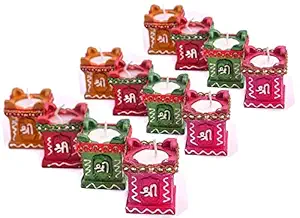परित्राणाय साधूनां विनाशाय च दुष्कृताम् ।
धर्मसंस्थापनार्थाय सम्भवामि युगे युगे ॥
बड़ी देर भई नंदलाला,
तेरी राह तके बृजबाला ।
बड़ी देर भई नंदलाला,
तेरी राह तके बृजबाला ।
ग्वाल-बाल इक-इक से पूछे
कहाँ है मुरली वाला रे
बड़ी देर भई नंदलाला,
तेरी राह तके बृजबाला ।
कोई ना जाए कुञ्ज गलिन में,
तुझ बिन कलियाँ चुनने को ।
तुझ बिन कलियाँ चुनने को ।
तरस रहे हैं..
तरस रहे हैं जमुना के तट,
धुन मुरली की सुनने को ।
अब तो दरस दिखा दे नटखट,
क्यों दुविधा में डाला रे ।
बड़ी देर भई नंदलाला,
तेरी राह तके बृजबाला ।
बड़ी देर भई नंदलाला,
तेरी राह तके बृजबाला ।
संकट में है आज वो धरती,
जिस पर तूने जनम लिया ।
जिस पर तूने जनम लिया ।
पूरा कर दे...
पूरा कर दे आज वचन वो,
गीता में जो तूने दिया ।
कोई नहीं है तुझ बिन मोहन,
भारत का रखवाला रे ।
बड़ी देर भई नंदलाला,
तेरी राह तके बृजबाला ।
बड़ी देर भई नंदलाला,
तेरी राह तके बृजबाला ।
ग्वाल-बाल इक-इक से पूछे
कहाँ है मुरली वाला रे ।
बड़ी देर भई नंदलाला,
तेरी राह तके बृजबाला ।
बड़ी देर भई नंदलाला,
तेरी राह तके बृजबाला ।
Overview of "Badi Der Bhayi Nandlala"
Title & Meaning
'Badi Der Bhayi Nandlala' is a devotional bhajan celebrating Lord Krishna’s childhood and his playful leelas.
Artist & Recording Details
Performed by popular bhajan singers; available in live temple sessions and devotional music albums.
Genre & Occasion
Hindu devotional bhajan, typically sung during Krishna Janmashtami, morning aartis, and special Krishna worship events.
Language & Dialect
Lyrics are primarily in Hindi and Braj Bhasha, preserving the traditional devotional style.
Popularity & Versions
Popular in temples and households; multiple renditions exist online and in classical bhajan collections.
Lyrics Structure & Themes
Devotional Invocation
The bhajan begins by invoking Lord Krishna, expressing love and reverence for his divine presence.
Repetitive Chorus
Chorus sections are repeated for devotional emphasis and to encourage collective singing among devotees.
Imagery & Symbolism
Lyrics depict Krishna’s childhood, playful acts, and leelas, invoking vivid spiritual imagery.
Community & Togetherness
Encourages group participation, uniting devotees in song and worship.
Emotional Resonance
Evokes feelings of love, devotion, joy, and nostalgia for Krishna’s divine stories.
Musical & Performance Elements
Instrumentation & Rhythm
Traditional instruments like harmonium, tabla, dholak, and manjira provide melody and rhythm.
Tempo & Dynamics
Tempo is moderate, allowing devotees to reflect, sing along, and perform devotional gestures.
Live vs Studio Renditions
Live renditions in temples often feature audience participation; studio versions are more polished and melodic.
Dance Cues & Movements
Though mainly sung, bhajan sessions may include simple devotional movements or hand gestures.
Audience Participation
Encourages devotees to clap, sing together, and immerse in devotional atmosphere.
Festival & Cultural Significance
Joyful Devotion
Instills happiness, love, and spiritual engagement during bhajan sessions.
Krishna Janmashtami Connection
Central to Janmashtami celebrations, recalling Krishna’s birth and childhood stories.
Spiritual Meaning
The bhajan emphasizes love, surrender, and devotion towards Lord Krishna.
Preservation of Bhakti Tradition
Represents the continuation of traditional bhakti songs, passed down through generations.
Community Bonding
Brings devotees together for collective singing, meditation, and worship.
How to Use & Share
Translations & Transliteration
Providing translations and transliterations helps non-Hindi or non-Braj speaking devotees understand the meaning.
Audio / Video Embeds
Embed live temple performances or recorded bhajans to engage devotees online.
Printable Lyrics & PDF Downloads
Provide downloadable PDF lyrics for personal worship or group bhajan sessions.
Performance & Singing Tips
Offer guidance on melody, rhythm, and pronunciation for devotees to sing correctly.
SEO & Social Media
Optimize content with keywords like Badi Der Bhayi Nandlala, Krishna Bhajan, Janmashtami; add social sharing options.
'Badi Der Bhayi Nandlala' is a devotional bhajan celebrating Lord Krishna’s childhood and his playful leelas.
Performed by popular bhajan singers; available in live temple sessions and devotional music albums.
Hindu devotional bhajan, typically sung during Krishna Janmashtami, morning aartis, and special Krishna worship events.
Lyrics are primarily in Hindi and Braj Bhasha, preserving the traditional devotional style.
Popular in temples and households; multiple renditions exist online and in classical bhajan collections.
The bhajan begins by invoking Lord Krishna, expressing love and reverence for his divine presence.
Chorus sections are repeated for devotional emphasis and to encourage collective singing among devotees.
Lyrics depict Krishna’s childhood, playful acts, and leelas, invoking vivid spiritual imagery.
Encourages group participation, uniting devotees in song and worship.
Evokes feelings of love, devotion, joy, and nostalgia for Krishna’s divine stories.
Traditional instruments like harmonium, tabla, dholak, and manjira provide melody and rhythm.
Tempo is moderate, allowing devotees to reflect, sing along, and perform devotional gestures.
Live renditions in temples often feature audience participation; studio versions are more polished and melodic.
Though mainly sung, bhajan sessions may include simple devotional movements or hand gestures.
Encourages devotees to clap, sing together, and immerse in devotional atmosphere.
Instills happiness, love, and spiritual engagement during bhajan sessions.
Central to Janmashtami celebrations, recalling Krishna’s birth and childhood stories.
The bhajan emphasizes love, surrender, and devotion towards Lord Krishna.
Represents the continuation of traditional bhakti songs, passed down through generations.
Brings devotees together for collective singing, meditation, and worship.
Providing translations and transliterations helps non-Hindi or non-Braj speaking devotees understand the meaning.
Embed live temple performances or recorded bhajans to engage devotees online.
Provide downloadable PDF lyrics for personal worship or group bhajan sessions.
Offer guidance on melody, rhythm, and pronunciation for devotees to sing correctly.
Optimize content with keywords like Badi Der Bhayi Nandlala, Krishna Bhajan, Janmashtami; add social sharing options.


